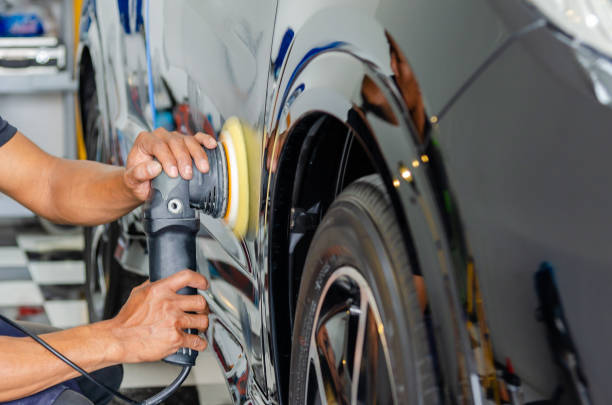Ceramic coating paint correction is an advanced technique designed to restore and enhance your vehicle’s paintwork, offering both aesthetic and protective benefits. If you’re looking to bring your car’s paint back to its original shine while providing a durable shield against environmental damage, this guide will walk you through the essentials of ceramic coating and paint correction in Fort Lauderdale FL.
What Is Paint Correction?
Paint correction is a process that involves removing imperfections from a vehicle’s paint surface. This typically includes scratches, swirl marks, oxidation, and other blemishes that can dull the appearance of your car. By using specialized polishing compounds and machines, paint correction can restore the paint’s clarity and gloss, making it look as good as new.
Why Paint Correction Matters
Paint correction is crucial for maintaining the appearance and value of your vehicle. Over time, your car’s paint can accumulate scratches and blemishes from various sources such as road debris, washing, and environmental contaminants. By correcting these imperfections, you not only enhance the visual appeal but also prepare the surface for further treatments like ceramic coating.
What Is Ceramic Coating?
Ceramic coating is a liquid polymer applied to the exterior surfaces of a vehicle. It chemically bonds with the factory paint, creating a protective layer that shields the paint from contaminants, UV rays, and minor scratches. Unlike traditional waxes and sealants, ceramic coatings offer long-lasting protection and a high-gloss finish.
Benefits of Ceramic Coating
Enhanced Protection: Ceramic coatings provide a robust barrier against environmental hazards, such as acid rain, bird droppings, and road salts.
UV Protection: The coating helps prevent paint oxidation and fading caused by prolonged exposure to the sun.
Hydrophobic Properties: Ceramic coatings repel water, making it easier to clean and reducing water spots.
Improved Aesthetics: The coating enhances the paint’s depth and shine, giving your vehicle a glossy finish.
How Does Ceramic Coating Work?
Ceramic coating works through a chemical reaction that bonds the coating to the vehicle’s paint. The coating contains nanoparticles that fill in the microscopic imperfections on the paint surface. Once cured, the coating forms a hard, glass-like layer that provides durable protection.
Preparation: The vehicle is thoroughly cleaned to remove any dirt, grime, or previous waxes. This step is crucial to ensure that the ceramic coating adheres properly.
Paint Correction: Any imperfections in the paint are corrected using polishing compounds and machines. This step ensures a smooth surface for the coating application.
Ceramic Coating Application: The ceramic coating is applied in small sections and buffed to ensure even coverage. This process may require multiple layers for optimal protection.
Curing: After application, the coating needs to cure. This typically takes a few hours to a day, depending on the product used.
Choosing the Right Ceramic Coating
When selecting a ceramic coating, consider the following factors:
- Durability: Some coatings offer protection for several years, while others may need reapplication more frequently.
- Gloss Level: Different coatings provide varying levels of gloss and shine.
- Hydrophobic Properties: Evaluate how well the coating repels water and other contaminants.
- Cost: Higher-quality coatings may come at a premium but often offer better protection and longevity.
DIY vs. Professional Application
While DIY ceramic coating kits are available, professional application is often recommended for optimal results. Professionals have the expertise and equipment to ensure that the coating is applied correctly and evenly, providing better protection and a longer-lasting finish.
Maintenance Tips for Ceramic Coated Vehicles
To maximize the benefits of ceramic coating, follow these maintenance tips:
Regular Washing: Use a pH-balanced car shampoo to clean the vehicle. Avoid abrasive cleaners that can damage the coating.
Avoid Harsh Chemicals: Steer clear of harsh chemicals and solvents that can degrade the coating.
Use a Soft Cloth: When drying the vehicle, use a microfiber cloth to prevent scratches.
Periodic Inspections: Regularly inspect the coating for any signs of wear and address any issues promptly.
FAQs
How long does ceramic coating last?
Ceramic coatings can last anywhere from 2 to 5 years, depending on the product and maintenance. High-quality coatings with proper care can offer longer-lasting protection.
Can ceramic coating fix scratches?
Ceramic coating does not fix existing scratches but can prevent new ones from forming and reduce the appearance of minor imperfections.
Is ceramic coating worth the investment?
Yes, ceramic coating is a worthwhile investment for those seeking long-term protection and enhanced appearance for their vehicle. It provides superior protection compared to traditional waxes and sealants.
How long does the ceramic coating application take?
The application process typically takes several hours, including preparation, paint correction, and curing time. Professional services may require a full day or more.
Can I apply ceramic coating myself?
While DIY kits are available, professional application is recommended for the best results. Professionals ensure that the coating is applied evenly and correctly, maximizing its effectiveness.
Conclusion
Professional ceramic coating paint correction is a powerful combination that restores your vehicle’s appearance and provides long-lasting protection. By understanding the process and benefits, you can make an informed decision about whether this advanced treatment is right for your car. Whether you choose to apply it yourself or seek professional help, ceramic coating is a worthwhile investment in your vehicle’s longevity and aesthetics.


